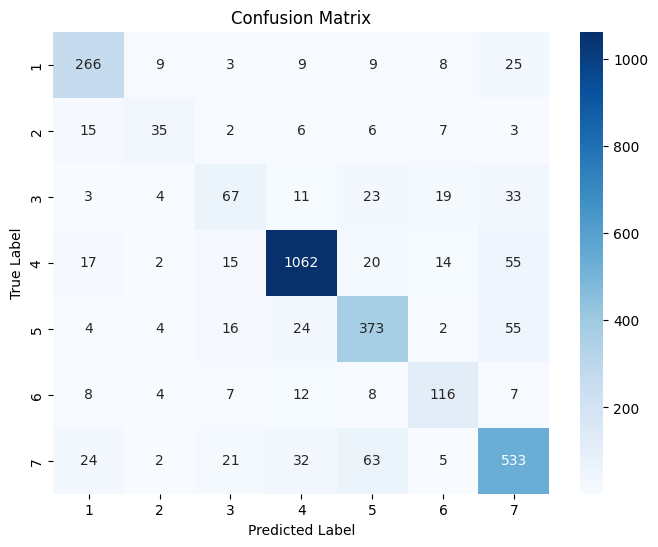Custom ResNet-18 for 7-Class Classification
This is a fine-tuned ResNet-18 model designed for a 7-class classification task. The model replaces all ReLU activation functions with PReLU, introduces Dropout2D layers for better generalization, and was trained on RAF-DB DATASET with various augmentations.
📜 Model Details
- Base Model: ResNet-18.
- Activations: ReLU layers replaced with PReLU.
- Dropout: Dropout2D applied to enhance generalization.
- Classes: 7 output classes.
- Input Size: Images with customizable dimensions (default:
[100, 100]). - Normalization: Input images are normalized using the following statistics:
- Mean:
[0.485, 0.456, 0.406] - Std:
[0.229, 0.224, 0.225]
- Mean:
📈 Evaluation Metrics on Test Data
Accuracy: 79.92%
Precision: 79.80%
Recall: 79.92%
F1-Score: 79.80%
Classification Report:
precision recall f1-score support
1 0.79 0.81 0.80 329
2 0.58 0.47 0.52 74
3 0.51 0.42 0.46 160
4 0.92 0.90 0.91 1185
5 0.74 0.78 0.76 478
6 0.68 0.72 0.70 162
7 0.75 0.78 0.77 680
accuracy 0.80 3068
macro avg 0.71 0.70 0.70 3068
weighted avg 0.80 0.80 0.80 3068
🧑💻 How to Use
You can load the model weights and architecture for inference or fine-tuning with the provided files:
Using PyTorch
def get_out_channels(module):
if isinstance(module, nn.Conv2d):
return module.out_channels
elif isinstance(module, nn.BatchNorm2d):
return module.num_features
elif isinstance(module, nn.Linear):
return module.out_features
return None
def replace_relu_with_prelu_and_dropout(module, inplace=True):
for name, child in module.named_children():
replace_relu_with_prelu_and_dropout(child, inplace)
if isinstance(child, nn.ReLU):
out_channels = None
for prev_name, prev_child in module.named_children():
if prev_name == name:
break
out_channels = get_out_channels(prev_child) or out_channels
if out_channels is None:
raise ValueError(f"Cannot determine `out_channels` for {child}. Please check the model structure.")
prelu = PReLU(device=device, num_parameters=out_channels)
dropout = nn.Dropout2d(p=0.2)
setattr(module, name, nn.Sequential(prelu, dropout).to(device))
model = models.resnet18(weights = models.ResNet18_Weights.IMAGENET1K_V1).train(True).to(device)
replace_relu_with_prelu_and_dropout(model)
# print(model.fc.in_features)
number = model.fc.in_features
module = []
module.append(LazyLinear(7))
model.fc = Sequential(*module).to(device)
state_dict = load_file("model.safetensors")
model.load_state_dict(state_dict)
model.eval()
⚠️ Limitations and Considerations
Input Dimensions: Make sure your input images are resized to the expected dimensions (100x100) before inference.
Number of Classes: The trained model supports exactly 7 classes as defined in the training dataset.
Output: The model output should be a probability of each of the 7 face type labels. Don't forget to use the softmax function to make predictions. Note that softmax is not used in the last layer of this model's architecture.
- Downloads last month
- 5
